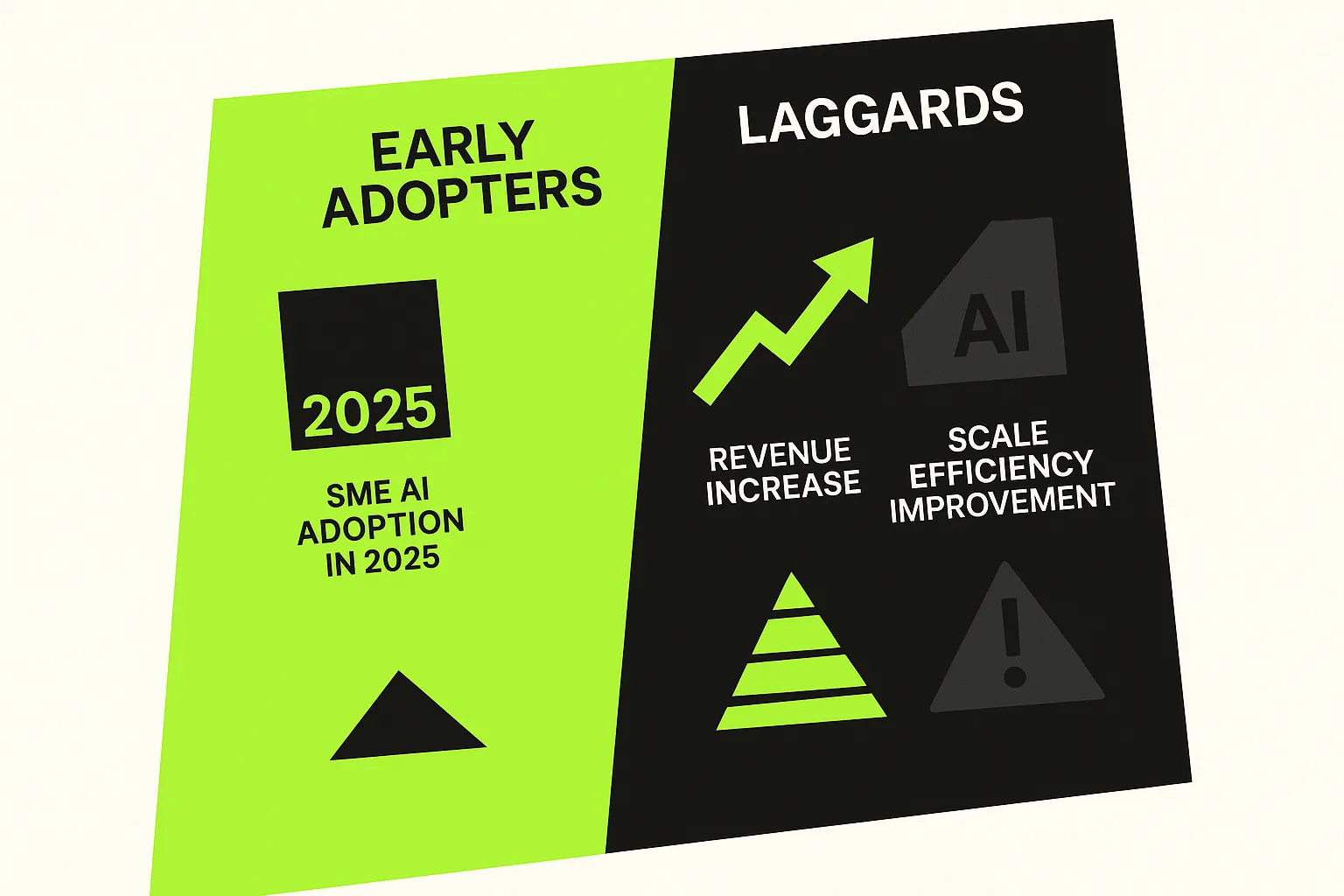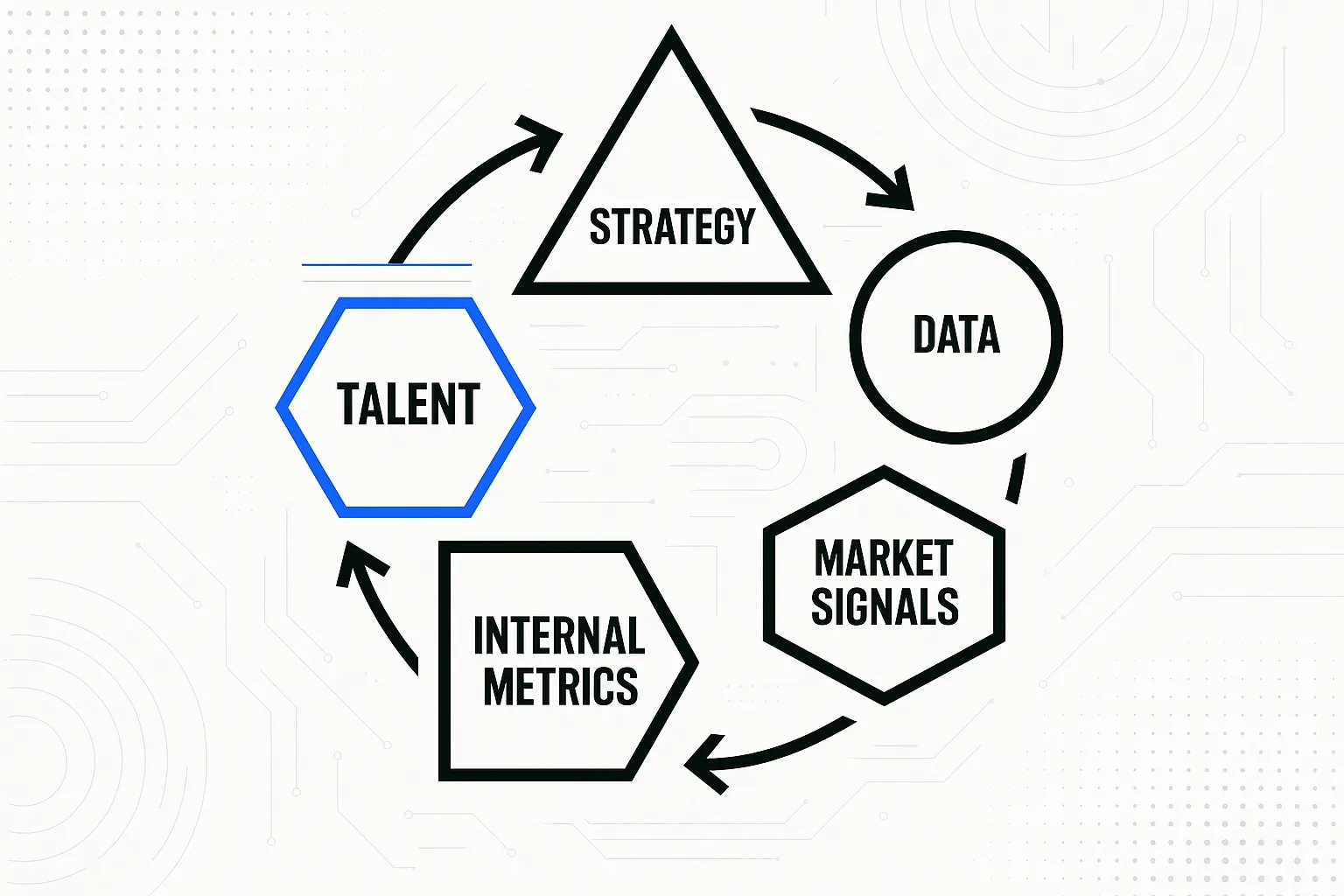Your Business's AI 'Point of No Return' Is Closer Than You Think
AI Summary
Understanding where your business stands in relation to its AI point of no return is essential for timely action. This article guides SME leaders through assessing urgency, recognizing warning signs, and implementing effective AI strategies.
- Who: Small and medium-sized business leaders evaluating AI adoption urgency.
- What: The critical assessment of AI implementation urgency and strategies to avoid falling behind competitors.
- When: Immediate consideration as AI adoption among SMEs accelerates in the next year.
- Where: Competitive SME markets facing rapid AI-driven transformation.
- Why: To gain efficiency, increase profits, scale effectively, and prevent irreversible competitive disadvantages.
For many small and medium-sized businesses, the conversation around artificial intelligence has been a distant hum of possibility. It was something to watch, a trend for larger corporations to explore. That era is definitively over. The question is no longer if AI will impact your business, but when the cost of ignoring it becomes an existential threat.
This isn't about chasing the latest ai hype. It's about recognizing a fundamental shift in the competitive landscape. Data shows that SME adoption of AI is set to jump from 26% in 2024 to 39% in 2025. This isn't just a trend. It's a tipping point. Businesses that delay action are not just standing still; they are actively choosing to fall behind. Understanding where your business stands in relation to this point of no return is the most critical strategic decision you'll make this year.
The Widening Gap: Data on the Cost of Inaction
The gap between AI adopters and laggards isn't a future problem. It's happening now, and the metrics are stark. Companies that wait are not just missing out on opportunities. They are conceding ground in efficiency, profitability, and their ability to scale.
The evidence is clear. A staggering 91% of SMEs already using AI report significant revenue boosts. This isn't a minor uptick. It's a clear indicator that AI-powered operations translate directly to a healthier bottom line.
The advantages compound from there. According to Salesforce data, 87% of AI-adopting SMEs scale more efficiently, and 86% see improved profit margins. While you are struggling with manual processes and rising operational costs, your competitors are automating workflows, personalizing customer experiences, and making data-driven decisions that widen their lead with every passing quarter. The cost of inaction is a compounding debt against your future growth.

Diagnostic Framework: Assess Your AI Urgency Score
Major consulting firms offer complex AI readiness frameworks designed for enterprises with dedicated strategy teams. For an SME leader, that advice can feel abstract and paralyzing. What you need is a practical way to diagnose your own situation right now.
This simple five-pillar framework is designed to help you pinpoint your vulnerabilities and quantify your urgency. Consider each pillar and honestly assess where your business stands.

The Five Pillars of AI Urgency
- Competitive Pressure: Are your direct competitors launching AI-powered features or services? Are new, AI-native startups entering your market and winning customers on efficiency or price? A 'yes' here means your point of no return is imminent.
- Operational Drag: Are your teams spending significant time on repetitive, manual tasks like data entry, customer follow-ups, or report generation? Every hour spent on these tasks is an hour your AI-enabled competitor is spending on strategy and growth.
- Data Inefficiency: Do you collect customer and operational data but struggle to extract actionable insights from it? If your data sits in spreadsheets instead of driving real-time decisions, you are operating with a blindfold on.
- Customer Experience Gaps: Are you unable to deliver the personalized experiences that modern customers expect? Are you losing customers due to slow response times or a one-size-fits-all approach? AI is the engine of modern personalization.
- Scaling Barriers: Does growing your revenue require a linear increase in headcount and operational costs? If you cannot scale without dramatically increasing overhead, your business model is fundamentally vulnerable to more efficient competitors.
A high sense of urgency in two or more of these pillars is a clear signal that the time for observation is over. Action is required.
Market Signals and Internal Warning Lights
Beyond a formal assessment, the warning signs are often all around you. You just need to know what to look for.
Market Signals Your Industry is at the Tipping Point
- Competitors are advertising "smarter," "faster," or "more personalized" services.
- Industry publications are filled with case studies of AI-driven success.
- Job postings in your sector increasingly ask for skills related to AI and data analysis.
- Customers begin asking about capabilities that are only possible through automation.
Internal Metrics That Signal You're Already Behind
- Your cost of customer acquisition is rising without a corresponding increase in customer lifetime value.
- You are losing bids or proposals to competitors who can deliver faster or at a lower cost.
- Employee morale is suffering due to a high volume of tedious, repetitive work.
- Your decision-making process is slow, relying on historical reports instead of real-time data.
These are not minor issues. They are the early tremors before the earthquake. They indicate that the foundational assumptions of your business are being challenged by a new technological reality.
Crossing the Rubicon: From Assessment to Action
Recognizing your proximity to the point of no return is the first step. The second is acting on it. This is where many businesses falter. The prospect of implementing an AI strategy can feel overwhelming, complex, and expensive. Research from BCG shows that 74% of companies struggle to scale and achieve tangible value from their AI initiatives. They get stuck in analysis paralysis or invest in the wrong tools, leading to frustration and wasted resources.
This is precisely why a clear, simple, and rapid implementation strategy is so critical. Crossing the rubicon doesn't mean you need to hire a team of data scientists or spend a year building a custom platform. It means identifying the highest-impact areas of your business and implementing targeted, automated systems that deliver results quickly.
The goal is to move from diagnosis to action with confidence. It's about building momentum with initial wins that prove the ROI and pave the way for deeper integration. This is how you overcome inertia and begin building a compounding advantage instead of a compounding debt.

The Compounding Interest of Action
The decision you make today about AI will not have a linear impact on your business. It will have an exponential one.
Every day you wait, your competitors are getting smarter. Their systems are learning, their processes are becoming more efficient, and their understanding of your shared customers is deepening. They are earning compounding interest on their investment in AI.
Conversely, every day you delay, you accrue a compounding debt. The gap in efficiency widens, the cost to catch up grows, and the strategic options available to you narrow. The point of no return isn't a single moment. It is a threshold after which catching up becomes exponentially harder and more expensive.
By assessing your urgency and taking decisive action, you can shift from a position of vulnerability to one of strength. You can begin building your own compounding advantage, one automated system at a time.
Frequently Asked Questions
Isn't implementing AI too expensive and complex for a small business?
This is a common misconception. The key is to avoid large, monolithic projects. A modern approach focuses on implementing simple, targeted AI systems into existing workflows. This delivers a rapid return on investment without the need for massive capital expenditure or a dedicated data science team. The cost of inaction, as shown by the 86% of SMEs seeing better margins, is often far greater than the cost of a strategic, phased implementation.
How quickly can we see a return on investment?
With the right strategy, results can be remarkably fast. pageBody.ai's model, for example, is designed to implement systems that can triple revenue potential within two weeks. The focus is on high-impact automations that address immediate pain points in sales, marketing, or operations, ensuring that the ROI is felt almost immediately.
We don't have an AI or data science team. Can we still succeed?
Absolutely. Success with AI for an SME is not about hiring PhDs. It's about partnering with experts who can translate your business goals into a functional AI strategy. An AI transformation agency handles the technical complexity, allowing you to focus on running your business while benefiting from the technology.
What if we choose the wrong AI tools or strategy?
This is a valid concern and a primary cause of the 74% failure-to-scale rate. It highlights the importance of starting with strategy, not technology. A proper assessment of your business ecosystem should dictate the tools, not the other way around. Working with a partner who offers a money-back guarantee can also de-risk the process, ensuring the solution delivers real value.


